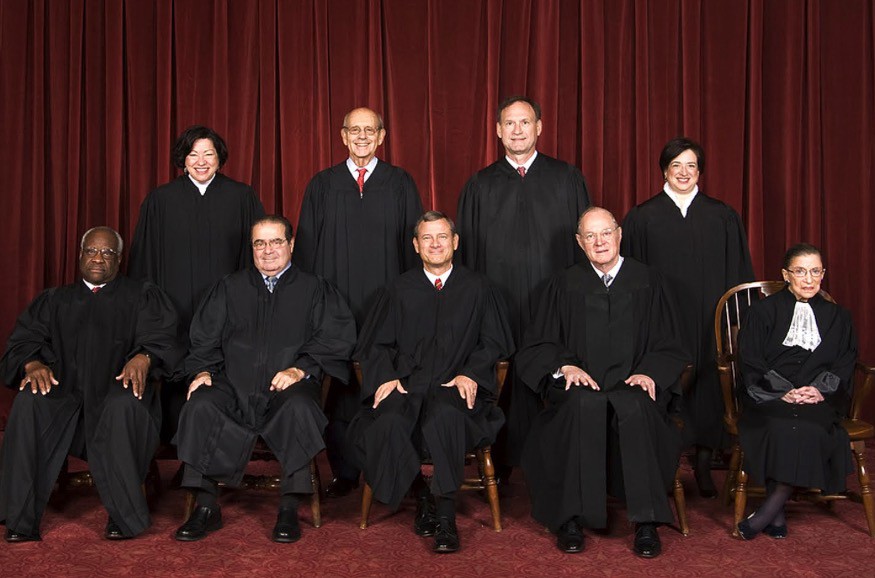Supreme Court Inspirations

Last week, the court made history; this week, it’s making history again. Justice Kennedy wrote last week’s stirring majority opinion in Obergefell v. Hodges. This week, he joins the majority opinion, written by Justice Alito, in Glossip v. Gross. Here are some of the most memorable passages.
The prisoners failed to identify a known and available alterna- tive method of execution that entails a lesser risk of pain, a requirement of all Eighth Amendment method-of- execution claims
Wow.
Second, the District Court did notcommit clear error when it found that the prisoners failed to establish that Oklahoma’s use of a massive dose of midazolam in its execution protocol entails a substantial risk of severe pain.
Yes…
The death penalty was an accepted punishment at the time of the adoption of the Constitution and the Bill of Rights. In that era, death sentences were usually carried out by hanging.
Historic.
In 1921, the Nevada Legislature adopted another new method of execution, lethal gas, after concluding that this was “the most humane manner known to modern science.”
I love the Supreme Court!
After Gregg reaffirmed that the death penalty does not violate the Constitution, some States once again sought a more humane way to carry out death sentences.
Right on.
While methods of execution have changed over the years, “[t]his Court has never invalidated a State’s chosen procedure for carrying out a sentence of death as the infliction of cruel and unusual punishment.”
Hear this.
[B]ecause some risk of pain is inherent in any method of execution, we have held that the Constitu- tion does not require the avoidance of all risk of pain
Finally.
After all, while most humans wish to die a painless death, many do not have that good fortune. Holding that the Eighth Amendment demands the elimination of essen- tially all risk of pain would effectively outlaw the death penalty altogether.
Yes.
After other efforts to procure sodium thiopental proved unsuccessful, States sought an alternative, and they even- tually replaced sodium thiopental with pentobarbital, another barbiturate. In December 2010, Oklahoma be- came the first State to execute an inmate using pentobar- bital.
Historic.
Petitioners concede that pentobarbi- tal, like sodium thiopental, can “reliably induce and main- tain a comalike state that renders a person insensate to pain” caused by administration of the second and third drugs in the protocol.
Hell yes they do.
The Lockett execution caused Oklahoma to implement new safety precautions as part of its lethal injection proto- col. When Oklahoma executed Lockett, its protocol called for the administration of 100 milligrams of midazolam, as compared to the 500 milligrams that are currently re- quired. On the morning of his execution, Lockett cut himself twice at “ ‘the bend of the elbow.’ ” That
evening, the execution team spent nearly an hour making at least one dozen attempts to establish intravenous (IV) access to Lockett’s cardiovascular system, including at his arms and elsewhere on his body.
Wait.
The team eventually believed that it had established intravenous access through Lockett’s right femoral vein, and it covered the injection access point with a sheet, in part to preserve Lockett’s dignity during the execution.
Hoooooollld on. I wasn’t reading this very closely.
Lockett began to move and speak, at which point the physician lifted the sheet and determined that the IV had “infiltrated,” which means that “the IV fluid, rather than entering Lockett’s blood stream, had leaked into the tissue surrounding the IV access point.” Warner v. Gross, 776 F. 3d 721, 725 (CA10 2015) (case below). The execution team stopped administering the remaining potassium chloride and terminated the execu- tion about 33 minutes after the midazolam was first in- jected. About 10 minutes later, Lockett was pronounced dead.
Oh my god.
The Eighth Amendment, made applicable to the States through the Fourteenth Amendment, prohibits the inflic- tion of “cruel and unusual punishments.”
I…
The inmates conceded that the protocol, if properly administered, would result in a humane and constitutional execution because sodium thiopental would render an inmate oblivious to any pain caused by the second and third drugs.
Oh no.
Our first ground for affirmance is based on petitioners’ failure to satisfy their burden of establishing that any risk of harm was substantial when compared to a known and available alternative method of execution.
…
Tellingly silent about the methods of execution most commonly used before States switched to lethal injection (the electric chair and gas chamber), the principal dissent implies that it would be unconstitutional to use a method that “could be seen as a devolution to a more primitive era.” Ibid. If States cannot return to any of the “more primitive” methods used in the past and if no drug that meets with the principal dissent’s approval is available for use in carrying out a death sentence, the logical conclusion is clear. But we have time and again reaffirmed that capital punishment is not per se unconstitutional.
………….
Finally, we find it appropriate to respond to the princi- pal dissent’s groundless suggestion that our decision is tantamount to allowing prisoners to be “drawn and quar- tered, slowly tortured to death, or actually burned at the stake.” Post, at 28. That is simply not true, and the prin- cipal dissent’s resort to this outlandish rhetoric reveals the weakness of its legal arguments.
For these reasons, the judgment of the Court of Appeals for the Tenth Circuit is affirmed.
It is so ordered.
